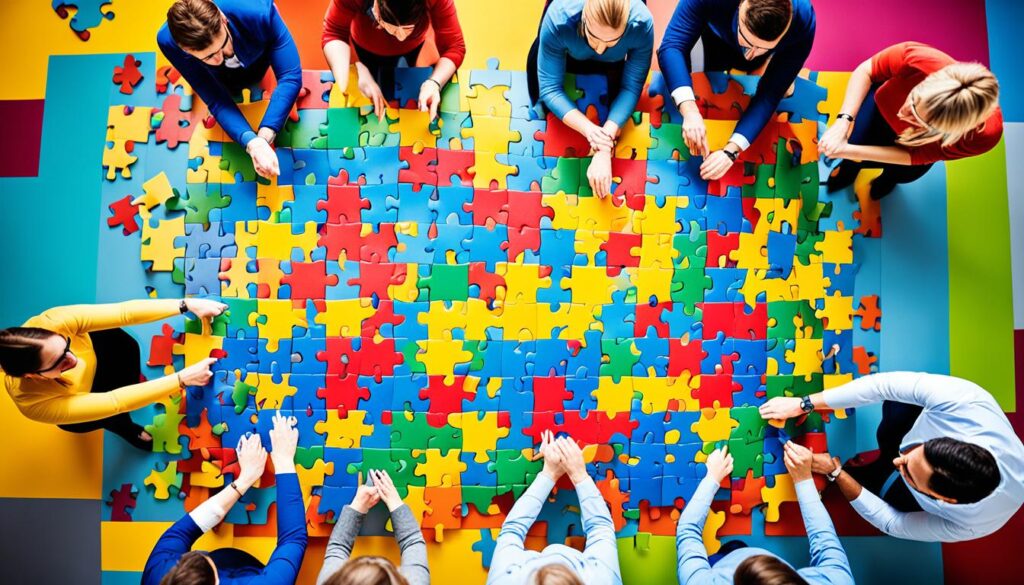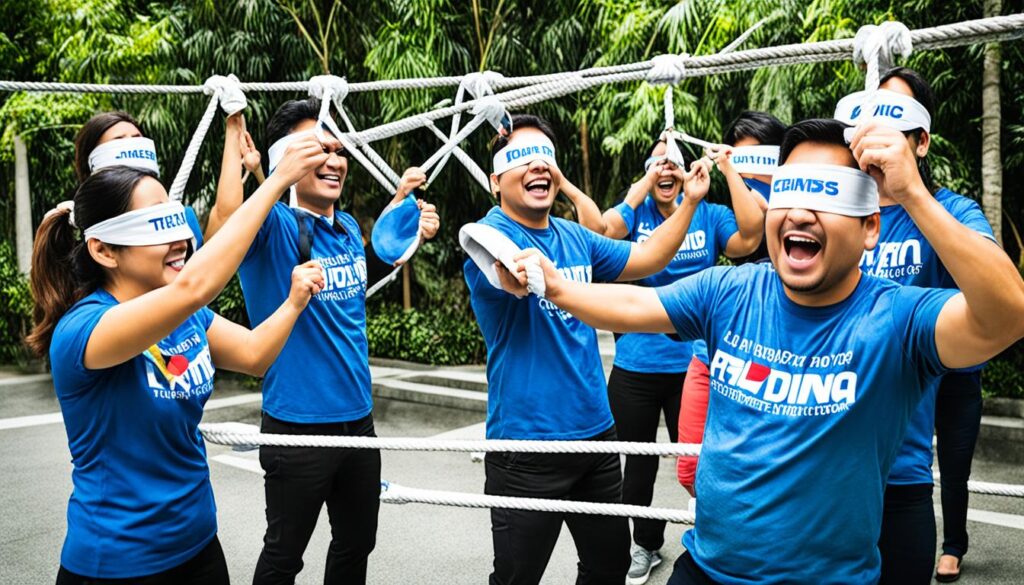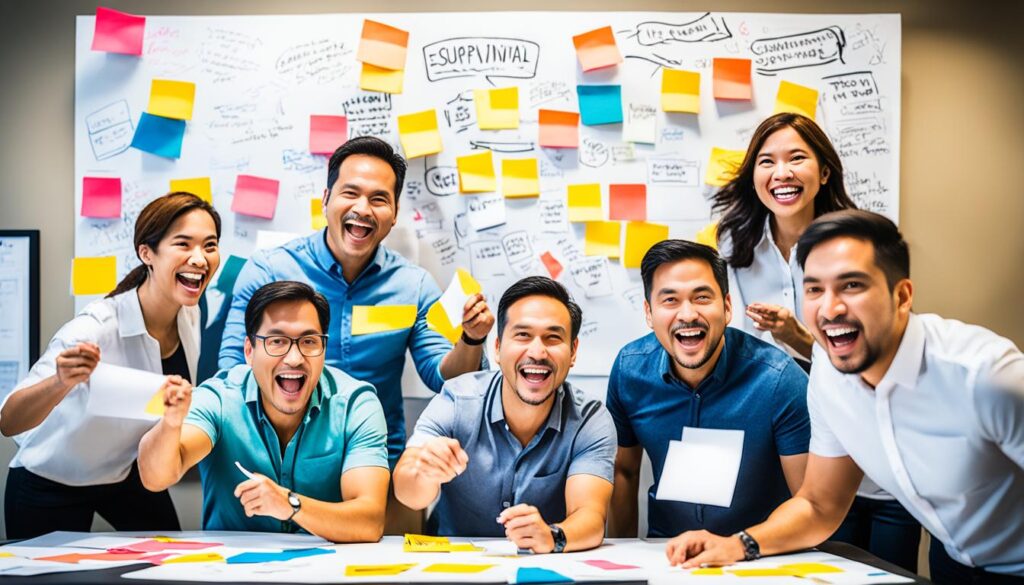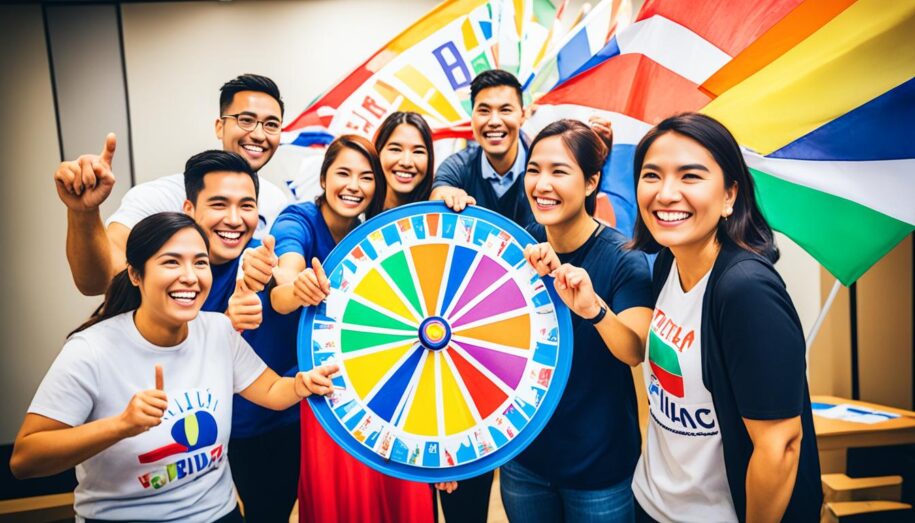Are you tired of dull and uninspiring team building activities? Do you want to find exciting themes that will truly engage your employees? Look no further! In this article, we will explore a variety of team building themes and activities that will ignite passion and collaboration among your team members. Get ready to boost employee engagement and create a more cohesive and motivated workforce!
Key Takeaways:
- Team building activities are essential for fostering job satisfaction and employee engagement.
- Exciting team building themes can actively engage employees and promote a sense of collaboration and camaraderie.
- By incorporating these themes into your team building efforts, you can create a more cohesive and motivated workforce.
- Stay tuned for the following sections as we delve deeper into the role of team building in employee engagement and explore various team bonding activities and strategies.
- Unlock the potential of your team and discover the power of engaging team building themes!
Understanding the Role of Team Building in Employee Engagement
Team building plays a crucial role in enhancing employee engagement within an organization. It goes beyond just organizing fun activities for employees. By engaging employees in interactive and collaborative activities, team building facilitates effective communication, builds trust and camaraderie, and fosters a sense of belonging.
When employees are engaged, they are more motivated, productive, and committed to their work. This translates into higher job satisfaction, lower turnover rates, and overall organizational success.
Team building activities provide a structured platform for employees to connect with each other on a personal level, strengthening their relationships. Through these activities, team members are encouraged to collaborate, share ideas, and work together towards common goals. This fosters a sense of teamwork and unity, leading to improved communication and problem-solving skills.
Effective team building initiatives also help employees feel valued and appreciated. When employees feel a sense of belonging and importance within the organization, they are more likely to be engaged and committed to their work.
Additionally, team building activities can break down barriers and improve cross-functional relationships. When employees from different departments or hierarchical levels come together in a non-work environment, it helps create a more inclusive and collaborative workplace culture.
By understanding the importance of team building in promoting employee engagement, organizations can better strategize and implement effective team building initiatives. Investing in team building can yield numerous benefits, including increased employee satisfaction, improved collaboration, enhanced communication, and a stronger sense of unity among team members.
Creating Alignment with Group Collaboration Exercises
Effective collaboration is the cornerstone of a successful team. To foster a sense of unity and alignment among team members, organizations should incorporate group collaboration exercises into their team building efforts. These exercises not only promote teamwork but also help in aligning team goals and driving collective success.
Aligning Team Goals Through Interactive Challenges
Interactive challenges are an excellent way to align team goals. These challenges require team members to work together, communicate effectively, and strategize to overcome obstacles. By participating in these interactive challenges, team members develop a shared understanding of their objectives and gain insights into each other’s strengths and weaknesses.
For example, a team-building activity like an escape room challenge can encourage collaboration and problem-solving. As team members work together to solve puzzles and navigate through a series of clues, they align their efforts toward a common goal, ultimately enhancing team cohesion and unity.
Another example of an interactive challenge is a team-building game in which team members must collectively build a structure using limited resources. This activity requires collaboration, effective communication, and a shared vision, ensuring that everyone is working toward the same goal.
Collaborative Problem-Solving Initiatives
Collaborative problem-solving initiatives are another valuable tool for fostering alignment and teamwork. These initiatives encourage team members to come together to tackle complex problems and find innovative solutions. By working collaboratively, team members can combine their diverse perspectives, skills, and knowledge to overcome challenges.
One example of a collaborative problem-solving initiative is a brainstorming session, where team members gather to generate ideas and solutions for a specific problem or project. By engaging in open and collaborative discussions, team members align their thinking and collectively explore potential solutions.
Another example is a design thinking workshop, where teams work together to identify and solve customer problems. Through a collaborative and iterative process, team members align their efforts toward a common goal of delivering value to the customers.
By implementing group collaboration exercises such as interactive challenges and collaborative problem-solving initiatives, organizations can foster alignment among team members and drive collective success. These exercises promote effective communication, strengthen teamwork, and encourage innovative thinking. Ultimately, they create a supportive and cohesive team capable of achieving shared goals and overcoming challenges.
| Key Benefits of Group Collaboration Exercises |
|---|
| Enhanced teamwork and collaboration |
| Alignment of team goals and objectives |
| Improved communication and problem-solving skills |
| Foster a sense of unity and camaraderie |
| Encourage innovative thinking |
Unlocking Creativity with Corporate Teamwork Events
Corporate teamwork events serve as a catalyst for unlocking creativity and fostering innovation within teams. These events provide a platform for employees to think outside the box and showcase their problem-solving and creative abilities. By creating team scenarios that challenge individuals to tackle complex tasks and generate innovative solutions, organizations can inspire their teams to push boundaries and reach new heights.
Fostering Innovation in Team Scenarios
Team scenarios are carefully designed to encourage collaboration, stimulate creative thinking, and foster a culture of innovation. These scenarios present teams with real-world challenges that require inventive problem-solving approaches. By working together, teams can pool their collective knowledge and expertise to devise innovative solutions, leading to the development of groundbreaking ideas and concepts.
By providing the right environment and team dynamics, corporate teamwork events allow individuals to tap into their creative potential and generate valuable ideas that drive organizational growth and success.
Through team scenarios, organizations can fuel innovation by promoting cross-functional collaboration and leveraging diverse perspectives. By bringing together team members from different backgrounds and areas of expertise, these events facilitate the exchange of ideas and spark innovative thinking.
Hosting Competitive Events to Spark Ingenuity
In addition to team scenarios, hosting competitive events further ignites the spark of ingenuity among employees. These events create a dynamic and exciting atmosphere that fuels motivation and brings out the best in individuals and teams. By fostering healthy competition, organizations can inspire employees to explore unconventional approaches, take risks, and come up with groundbreaking ideas to outperform their peers.
Competitive events challenge teams to think creatively and strategically, pushing them to go above and beyond their usual limits. The spirit of healthy competition sparks innovation and drives employees to find innovative solutions that differentiate them from their competitors.
The image above represents the energy and collaboration that corporate teamwork events bring, fostering innovation and creativity within teams.
By unlocking creativity through corporate teamwork events and fostering innovation in team scenarios, organizations can tap into the immense potential of their workforce. These events provide the ideal platform for employees to showcase their problem-solving skills, think innovatively, and contribute to the growth and success of the organization.
| Benefits of Unlocking Creativity | Fostering Innovation | Hosting Competitive Events |
|---|---|---|
| Promotes out-of-the-box thinking | Encourages cross-functional collaboration | Drives healthy competition |
| Fuels motivation and engagement | Sparks innovative ideas and concepts | Brings out the best in individuals and teams |
| Enhances problem-solving capabilities | Facilitates the exchange of diverse perspectives | Inspires employees to explore unconventional approaches |
Cultivating Effective Team Communication with Structured Workshops
Effective team communication is the cornerstone of successful collaboration and productivity. Clear and open lines of communication enable teams to work harmoniously, share ideas, and resolve conflicts efficiently. In order to cultivate effective team communication, organizations can leverage structured workshops as a valuable tool.
Structured workshops provide team members with dedicated time and space to enhance their communication skills. These workshops incorporate various communication exercises and strategies, allowing teams to practice active listening, express ideas effectively, and build rapport with one another. By participating in these workshops, team members can develop a deeper understanding of effective communication techniques and how to apply them in their daily interactions.
One effective strategy used in structured workshops is role-playing. Team members can engage in simulated scenarios that reflect real-life communication challenges they may face. This enables them to practice different communication approaches, gaining valuable insights and building confidence in their abilities.
Another crucial aspect of structured workshops is the emphasis on resolving conflicts constructively. Conflict resolution exercises help team members learn how to manage conflicts in a respectful and collaborative manner. By providing a safe environment for open dialogue, structured workshops encourage teams to address conflicts openly and find mutually beneficial solutions.
A significant benefit of structured workshops is the opportunity for teams to develop shared communication norms and strategies. Through guided activities, teams can establish effective communication processes, such as regular check-ins, clear and concise messaging, and active engagement during meetings. These shared communication norms foster a sense of trust, transparency, and collaboration among team members.
Structured workshops also provide an excellent platform for teams to explore and implement various team communication strategies. These strategies can include using online collaboration tools, establishing communication protocols, or creating shared platforms for knowledge sharing. By experimenting with different communication strategies in a structured workshop setting, teams can determine which approaches work best for them and optimize their communication practices.
By prioritizing effective team communication through structured workshops, organizations can lay the foundation for a cohesive and high-performing team. These workshops not only enhance communication skills but also strengthen relationships, improve collaboration, and boost overall team morale. Investing in structured workshops is an investment in the long-term success and productivity of the team.

| Benefits of Structured Workshops for Team Communication | Strategies for Effective Communication |
|---|---|
|
|
The Impact of Leadership Development Workshops on Team Cohesion
Leadership development workshops have a significant impact on team cohesion and are instrumental in driving organizational success. These workshops play a crucial role in identifying and nurturing team leaders who can effectively guide and motivate their teams. By providing employees with opportunities to develop their leadership qualities, organizations can enhance team dynamics and improve overall performance.
Identifying and Nurturing Team Leaders
Leadership development workshops are designed to identify individuals with the potential to become effective team leaders. Through assessments, group activities, and interactive sessions, these workshops allow organizations to identify employees who exhibit leadership qualities such as strong communication skills, decision-making abilities, and the ability to inspire and influence others.
Once potential leaders are identified, workshops provide targeted coaching and mentoring to help them further develop their leadership skills. This includes providing guidance on effective communication, conflict resolution, and decision-making, as well as imparting knowledge on how to motivate and engage team members.
Workshops for Developing Leadership Qualities Amongst Employees
In addition to identifying team leaders, leadership development workshops also focus on developing leadership qualities among all employees. These workshops provide valuable learning opportunities for individuals at all levels of the organization, allowing them to enhance their skills and contribute effectively to the team.
By participating in leadership development workshops, employees can gain a deeper understanding of leadership principles, learn how to effectively collaborate with their team members, and develop the confidence to take on leadership roles when necessary. These workshops also encourage employees to take initiative, think critically, and solve problems proactively.
| Benefits of Leadership Development Workshops | Impact on Team Cohesion |
|---|---|
| 1. Development of strong communication skills | 1. Improved communication and collaboration among team members |
| 2. Enhanced decision-making abilities | 2. Increased trust and cooperation within the team |
| 3. Improved motivation and engagement levels | 3. Strengthened sense of unity and shared goals |
| 4. Development of problem-solving skills | 4. More effective problem-solving and decision-making processes |
Overall, leadership development workshops have a profound impact on team cohesion. By identifying potential team leaders and developing leadership qualities among employees, organizations can create a cohesive and high-performing team that is motivated, engaged, and aligned towards achieving common goals.
Team Building Theme: Crafting the Ultimate Experience
Selecting Themes That Resonate with Your Workforce
The success of a team building activity lies in selecting a theme that resonates with your workforce. When employees feel connected to the theme, they are more likely to participate and engage wholeheartedly, leading to a more meaningful team building experience. Your chosen theme should align with the interests and values of your team members, creating a sense of excitement and enthusiasm.
To select the right theme, take into consideration the demographic of your workforce. Are they sports enthusiasts, nature lovers, or fans of pop culture? Understanding their preferences will help you choose a theme that will capture their interest. Additionally, consider the goals of your team building activity. Are you aiming to build trust, improve communication, or enhance problem-solving skills? The theme should align with these objectives and facilitate the desired outcomes.
When selecting team building themes, involve your employees in the decision-making process. Conduct surveys or have group discussions to gather their input and suggestions. This will give them a sense of ownership and make them more invested in the activity. By selecting themes that resonate with your workforce, you can create an inclusive and engaging team building experience that boosts team spirit and camaraderie.
Theme Ideas That Encourage Team Spirit and Camaraderie
Once you have understood your workforce and their preferences, it’s time to explore theme ideas that foster team spirit and camaraderie. Here are some creative theme ideas to inspire your next team building activity:
- Amazing Race Adventure: Design an exciting race-themed activity where teams work together to complete challenges and solve clues.
- Superhero Showdown: Encourage teams to embrace their inner superheroes and complete missions that require collaboration and problem-solving.
- Tropical Escape: Transport your team to a virtual tropical paradise with beach-themed activities and challenges that promote relaxation and team bonding.
- Movie Magic: Create a movie-themed experience where teams work together to produce their own short film, fostering collaboration and creativity.
- Game Night Extravaganza: Set up a variety of fun and interactive game stations, encouraging teams to compete and cooperate in friendly challenges.
These theme ideas are just a starting point. Feel free to customize and tweak them to align with your team’s interests and goals. Remember, the ultimate goal is to create an unforgettable team building experience that cultivates team spirit and camaraderie.

Virtual Team Building Games for Remote Workforces
In the era of remote work, virtual team building games have become incredibly popular for engaging remote workforces. These games offer a unique opportunity for teams to connect, collaborate, and build relationships, even when physically separated. By incorporating virtual team building games into your remote work strategy, you can foster team cohesion and create a sense of community among remote team members.
Virtual team building games are specifically designed to overcome the challenges of working remotely. They provide a platform for team members to interact, communicate, and bond in a fun and engaging manner. These games are often designed to promote teamwork, problem-solving, and creativity, all of which are important aspects of successful remote team collaboration.
When remote team members participate in virtual team building games, they not only strengthen their relationships but also develop a deeper understanding of each other’s strengths, skills, and communication styles. Through these games, remote workforces can improve collaboration, boost morale, and enhance overall team performance.
Virtual team building games come in various forms, including online scavenger hunts, virtual escape rooms, interactive quizzes, and virtual team challenges. These games can be customized to suit the specific needs and interests of your remote workforce, making them highly adaptable and engaging.
By incorporating virtual team building games into your remote work strategy, you are actively investing in employee engagement and empowerment. These games help remote team members feel connected, motivated, and supported, which ultimately contributes to the success of your remote workforce.
Innovative Team Bonding Activities for Enhanced Employee Relations
Team bonding activities are essential for building strong employee relations and fostering a positive work environment. These activities not only provide an opportunity for team members to connect on a personal level but also promote collaboration, trust, and a sense of belonging within the team.
When it comes to team bonding, innovation is key. By incorporating innovative activities into your team building efforts, you can create memorable experiences that strengthen the relationships between team members. These activities can range from creative problem-solving challenges to interactive scavenger hunts or even team-building workshops centered around a specific theme.
One example of an innovative team bonding activity is an escape room challenge. In this activity, team members are locked in a room and tasked with finding clues, solving puzzles, and working together to escape before time runs out. This activity not only encourages teamwork and communication but also brings a sense of excitement and fun.
Another example is a cooking competition, where teams are given a set of ingredients and have to work together to create a delicious dish within a specified time frame. This activity promotes collaboration, creativity, and problem-solving skills, all while fostering a sense of camaraderie as team members bond over their shared love of food.
Furthermore, outdoor adventure activities such as hiking, obstacle courses, or team sports can also be great options for team bonding. These activities provide opportunities for team members to challenge themselves, support each other, and build trust in a non-work setting. Outdoor activities also offer a change of scenery and a breath of fresh air, which can help refresh and rejuvenate team members.
No matter the activity, the key is to choose innovative team bonding activities that cater to the interests and preferences of your team members. By doing so, you can create a positive and engaging experience that strengthens employee relations and improves overall team dynamics.
“Innovation distinguishes between a leader and a follower.” – Steve Jobs
Overall, innovative team bonding activities are a powerful tool for enhancing employee relations and fostering a positive work environment. By incorporating these activities into your team building initiatives, you can create a stronger and more cohesive team that is motivated, engaged, and ready to tackle any challenge that comes their way.

Strategizing Employee Engagement Strategies Through Team Building
Team building is a powerful tool for driving employee engagement within an organization. By incorporating employee engagement strategies into team building activities, organizations can create a positive and motivating work environment. Engaged employees are more likely to be satisfied, productive, and committed to their organization, resulting in tangible benefits for both employees and the company.
Engagement Techniques That Yield Genuine Results
In order to achieve genuine results, it is important to implement engagement techniques that resonate with employees and align with their interests and values. Here are some effective engagement techniques to consider:
- Open and Transparent Communication: Establish a culture of open and transparent communication, where employees feel heard, valued, and involved in decision-making processes. Regularly solicit feedback, recognize employee contributions, and provide opportunities for two-way communication.
- Meaningful Work and Career Development: Provide employees with meaningful work that aligns with their skills and interests. Offer opportunities for professional growth and development, such as training programs, mentorship, and advancement paths.
- Recognition and Rewards: Recognize and reward employees for their accomplishments and efforts. Implement a comprehensive recognition program that acknowledges individual and team achievements, fostering a culture of appreciation and motivation.
- Flexible and Supportive Work Environment: Create a flexible and supportive work environment that promotes work-life balance, accommodates personal needs, and offers resources for physical and mental well-being. Support employee well-being initiatives, such as wellness programs and flexible work arrangements.
- Collaboration and Teamwork: Encourage collaboration and teamwork by providing opportunities for cross-functional projects, team-building activities, and fostering a sense of camaraderie among employees.
Measuring the Effects of Team Building on Engagement
Measuring the effects of team building on employee engagement is essential for understanding the impact of these activities and identifying areas for improvement. Here are some ways to measure engagement:
- Employee Surveys: Conduct regular employee surveys to gather feedback on engagement levels, satisfaction, and areas for improvement. Use survey results to track progress and make informed decisions about future engagement strategies.
- Attendance and Participation: Monitor attendance and participation rates for team building activities to gauge employee interest and engagement.
- Performance Metrics: Analyze performance metrics, such as productivity levels, employee turnover, and absenteeism rates, to assess the effectiveness of team building initiatives on overall engagement.
- Qualitative Feedback: Gather qualitative feedback through interviews, focus groups, or one-on-one discussions to gain deeper insights into employee experiences and perceptions of team building activities.
By strategizing employee engagement strategies through team building and consistently measuring the effects of these activities, organizations can continuously improve and optimize their efforts to enhance employee satisfaction, productivity, and retention.
Company Retreat Planning: A Gateway to Intensive Team Bonding
Company retreats provide a unique opportunity for intensive team bonding and relationship building. When properly planned and executed, retreats can create a positive and memorable experience for employees, fostering a strong sense of unity and camaraderie.

In this section, we will explore the importance of company retreat planning and discuss strategies for organizing a successful team bonding retreat. These insights will help organizations maximize the benefits of company retreats in promoting team cohesion and fostering a positive work culture.
Building an Inclusive Culture with Diverse Team Building Activities
Building an inclusive culture is essential for creating a diverse and accepting workplace. By fostering an environment that embraces diversity and promotes inclusion, organizations can unlock the full potential of their teams. Diverse team building activities play a significant role in promoting diversity and inclusion within teams, breaking down barriers, and fostering collaboration.
Activities Promoting Diversity and Inclusion
Engaging in team building activities that promote diversity and inclusion can create a sense of belonging for all team members and foster understanding and respect. Here are some activities you can incorporate:
- Community volunteering: Engage in community service activities that support diverse communities and give back to society.
- Cultural exchange: Organize cultural exchange events where team members can share their traditions, customs, and experiences with one another.
- Diversity workshops: Conduct workshops focused on educating team members about different cultures, perspectives, and identities to foster empathy and inclusivity.
- Inclusive team challenges: Design team building challenges that require collaboration and communication among team members with diverse backgrounds, abilities, and skills.
These activities not only promote diversity and inclusion but also encourage teamwork, empathy, and appreciation for individual differences.
Conclusion
Team building activities play a vital role in engaging employees, fostering teamwork, and creating a positive work environment. By incorporating exciting team building themes and strategies, organizations can promote collaboration, boost employee engagement, and enhance overall productivity. Whether it’s through virtual games, structured workshops, or company retreats, team building initiatives bring teams closer together and drive organizational success.
It is crucial for organizations to prioritize team building and ensure that it aligns with their employees’ interests and values. By doing so, organizations can create a strong and cohesive workforce that is motivated and engaged. Team building themes should resonate with employees and encourage team spirit and camaraderie. The right team bonding activities can strengthen employee relations and foster a positive work culture.
Additionally, strategic employee engagement strategies implemented through team building can create a positive and motivating work environment. By promoting engagement techniques that yield genuine results and measuring the effects of team building on employee engagement, organizations can enhance employee satisfaction, productivity, and retention.
In conclusion, team building is a powerful tool that should not be overlooked. By implementing impactful team building initiatives, organizations can foster collaboration, boost employee engagement, and create a motivated workforce. Investing in team building activities aligns with the interests and values of employees, creating a positive work environment that drives organizational success.
FAQ
What are some exciting team building themes to engage employees?
Some exciting team building themes to engage employees include outdoor adventure challenges, game shows and trivia nights, escape rooms, and multicultural celebrations.
Why is team building important for employee engagement?
Team building is important for employee engagement because it promotes effective communication, builds trust and camaraderie, and fosters a sense of belonging among team members.
What are some group collaboration exercises that can help align team goals?
Some group collaboration exercises that can help align team goals include team building workshops, brainstorming sessions, team problem-solving challenges, and team-building games.
How can corporate teamwork events unlock creativity and foster innovation?
Corporate teamwork events can unlock creativity and foster innovation by creating team scenarios that challenge employees’ problem-solving and creative thinking abilities and by hosting competitive events that inspire employees to think outside the box.
How can structured workshops improve team communication?
Structured workshops can improve team communication by providing opportunities for team members to practice sharing ideas, active listening, and resolving conflicts through various communication exercises and strategies.
What is the impact of leadership development workshops on team cohesion?
Leadership development workshops can enhance team cohesion by identifying and nurturing team leaders who can effectively guide and motivate their teams, thereby improving overall team dynamics and performance.
How can organizations select team building themes that resonate with their employees?
Organizations can select team building themes that resonate with their employees by considering their interests and values, conducting surveys or focus groups to gather input, and ensuring that the themes promote team spirit and camaraderie.
What are some virtual team building games for remote workforces?
Some virtual team building games for remote workforces include online trivia games, virtual escape rooms, virtual team scavenger hunts, and virtual icebreaker activities.
What are some innovative team bonding activities that can enhance employee relations?
Some innovative team bonding activities that can enhance employee relations include cooking classes, team sports tournaments, volunteer activities, and team-building workshops focused on personal development.
How can team building contribute to employee engagement strategies?
Team building contributes to employee engagement strategies by creating a positive and motivating work environment, strengthening relationships and trust among team members, and promoting collaboration and teamwork.
How can organizations plan a successful team bonding retreat?
Organizations can plan a successful team bonding retreat by clarifying their objectives, selecting an appropriate location, incorporating team building activities, designing a balanced schedule, and seeking feedback from participants.
What are some diverse team building activities that promote inclusion?
Some diverse team building activities that promote inclusion include cultural competency training, diversity workshops, team-building exercises that require cross-cultural collaboration, and employee resource group activities.
